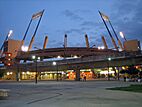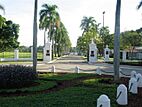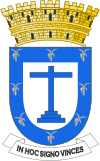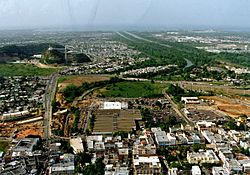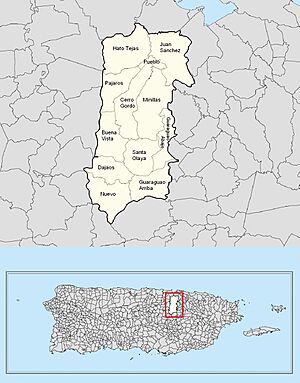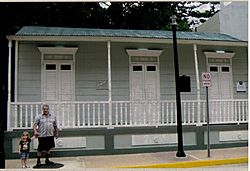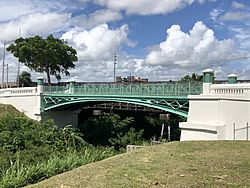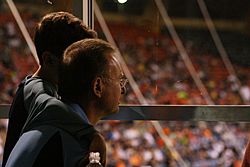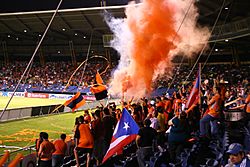Bayamón, Puerto Rico facts for kids
Quick facts for kids
Bayamón
Municipio Autónomo de Bayamón
|
|||
|---|---|---|---|
|
City and Municipality
|
|||
|
Bayamón City Hall above PR-2
Invención de la Santa Cruz Parish
Juan Ramón Loubriel Stadium
Tren Urbano at Deportivo station
Bayamón Correctional Complex
|
|||
|
|||
| Nicknames:
"La Ciudad del Chicharrón" (The Porkrind City), "La Ciudad de Vaqueros" (The City of Cowboys), La Ciudad de las Ciencias ("The City of Science"), "La Ciudad del Tapón" (The City of Traffic Jams)
|
|||
| Motto(s):
In Hoc Signo Vinces (Latin for: "By this sign you will conquer")
|
|||
| Anthem: "Bayamón, ciudad hermosa" | |||

Map of Puerto Rico highlighting Bayamón Municipality
|
|||
| Sovereign state | |||
| Commonwealth | |||
| Settled | 16th century | ||
| Founded | May 22, 1772 | ||
| Founded by | Don Juan Ramírez de Arellano | ||
| Barrios | |||
| Area | |||
| • Total | 44.53 sq mi (115.34 km2) | ||
| • Land | 44.38 sq mi (114.95 km2) | ||
| • Water | 0.15 sq mi (0.39 km2) | ||
| Elevation | 52 ft (16 m) | ||
| Population
(2020)
|
|||
| • Total | 185,187 | ||
| • Rank | 2nd in Puerto Rico | ||
| • Density | 4,158.42/sq mi (1,605.57/km2) | ||
| Demonym(s) | Bayamonese (neutral) Bayamonés (masculine) Bayamonesa (feminine) |
||
| Time zone | UTC-4 (AST) | ||
| ZIP Codes |
00956, 00957, 00959, 00961, 00960, 00958
|
||
| Area code(s) | 787/939 | ||
| Major routes | |||
| Website | municipiodebayamon.com | ||
Bayamón is a large city and municipality in Puerto Rico. It is located on the northeastern coast. Bayamón is surrounded by other towns like Guaynabo to the east and Toa Baja to the north. It is part of the San Juan metropolitan area. Bayamón has 11 main areas called barrios and a downtown area. With over 185,000 people, it is the second most populated city in Puerto Rico, right after the capital, San Juan.
Contents
What Does Bayamón Mean?
There are two ideas about where the name Bayamón comes from. One idea is that it was named after a local cacique (a Taino chief) named Bahamon. The other idea is that the name comes from the Taino word Bayamongo. This was the name of the river that flows through the area. So, Bayamón might mean "the area around this main river."
Fun Nicknames for Bayamón
Bayamón has some cool nicknames:
- "City of the Chicharrón" (Ciudad del Chicharrón): This is because of a popular fried snack called chicharrón volao that is often sold there.
- "City of Cowboys" (Ciudad de Vaqueros): This nickname comes from the city's local sports team, the Vaqueros de Bayamón.
- "City of the Sciences" (Ciudad de las Ciencias): This is because of a fun and educational place called the Parque de las Ciencias.
- "City of Traffic Jams" (Ciudad del Tapón): This nickname is more recent and refers to how much traffic there can be!
Bayamón's History
The Taino people were the first to live in this area. In 1750, a large farm called Hacienda Santa Cruz was built near the Bayamón River. On May 22, 1772, a Spanish settler named Juan Ramírez de Arellano officially started the town of Bayamón. The main church, Invención de la Santa Cruz Parish, was also built around this time.
In 1821, Marcos Xiorro, an African slave, planned a revolt against the sugar plantation owners. His plan was discovered, but Xiorro became a hero to many slaves.
After the Spanish–American War in 1898, Puerto Rico became a territory of the United States. In 1899, a count showed that Bayamón had about 19,940 people. The city grew a lot in the early 1900s. Many factories for textiles, fertilizer, and aluminum were built. Banks also opened, making Bayamón an important center for business and industry. The city's sewer system also got bigger.
Bayamón also hosted some events for the VIII Pan American Games in 1979.
In September 2017, Hurricane Maria hit Puerto Rico. It caused a lot of damage to buildings and roads in Bayamón. Many homes were destroyed, and the Goya Foods factory was also badly damaged.
Bayamón's Geography
Bayamón is located on the northern coast of Puerto Rico. It is part of the Northern Karst Belt, which means it has cool limestone hills. The city covers about 43.5 square miles (113.1 km2). Most of the land is flat, but there are some big hills like La Peña.
Bayamón is the second most populated city in Puerto Rico. It is part of the large metropolitan area that includes San Juan and other nearby cities. The city is served by the Luis Muñoz Marín International Airport.
Rivers in Bayamón
Several rivers flow through Bayamón, including:
- Río Bayamón
- Río Hondo
- Río Minillas
- Río Bucarabones
- Río Cuesta Arriba
Bayamón's Barrios
Like all towns in Puerto Rico, Bayamón is divided into smaller areas called barrios. The main city buildings, central square, and large church are in a barrio called "el pueblo".
Fun Things to Do in Bayamón
Bayamón has many interesting places to visit!
- Bayamón Central Park is a nice public park where people can relax.
- You can visit the Braulio Castillo Theater and the Francisco Oller Museum.
- The José Celso Barbosa Monument honors an important person from Puerto Rico.
- The Bayamón City Hall building is very unique. It's built right over a major highway! You can walk through a path above the road and see cars driving underneath. It's thought to be the only building like it in the world.
Explore Science and Nature
- One of the most popular places is the Parque de las Ciencias (Science Park). It's a science-themed park with lots of cool exhibits and attractions. It's located among hills, and from an observation building, you can get a great view of the city.
- El Parque del Tren used to have Puerto Rico's only working train. Today, it's a smaller area called "Parque del Nino" or "Children's Park," with a plaza and a jogging path.
- The Paseo del Rio (Linear Path) near the Bayamón River is a 6-mile long path. It's perfect for jogging, walking, or cycling. It even has separate lanes for bikes and walkers.
- The Rio Bayamón Golf Course is located near the path.
- Julio Enrique Monagas Park has trails for mountain biking and cliffs for rappelling. It's a great place for outdoor adventures!
Shopping and History
- If you like shopping, Bayamón has big malls like Plaza del Sol and Plaza Rio Hondo.
- The Ron Del Barrilito distillery at the Hacienda Santa Ana is the oldest rum distillery in Puerto Rico. The hacienda also has a nature trail to explore.
- A suspension bridge in Bayamón is only for people walking. When it was built, it was one of only three like it in Puerto Rico.
Culture and Events
Festivals and Celebrations
Bayamón celebrates its patron saint festival in May. This Festival de la Santa Cruz is a religious and cultural event. It usually has parades, games, local crafts, rides, food, and live music.
Other fun events in Bayamón include:
- José Celso Barbosa Birthday Commemoration – in July
- Tree Lighting Ceremony – in November, celebrating the start of the Christmas season
- Caminata por la diabetes (Diabetes Walk) – in November, to raise awareness
Sports in Bayamón
Bayamón is a big sports city!
- The Vaqueros de Bayamón are the city's basketball team. They play in the Baloncesto Superior Nacional league. They have won the most championships in the league's history (15!). Their home court is the Coliseo Rubén Rodríguez.
- There was also a baseball team called the Vaqueros de Bayamón. They played at Juan Ramón Loubriel Stadium.
- The city has a women's volleyball team called the Vaqueras de Bayamón.
- Bayamón was home to professional soccer teams like the Puerto Rico Islanders and Puerto Rico FC. They also played at Juan Ramón Loubriel Stadium.
- The city's main soccer team today is Bayamón FC, founded in 1999. They play at the Bayamón Soccer Complex.
- Many famous boxers are from Bayamón, including International Boxing Hall of Fame member Hector Camacho.
| Club | Sport | League | Venue | League Championships |
|---|---|---|---|---|
| Bayamón FC | Football | Liga Puerto Rico | Bayamón Soccer Complex | |
| Vaqueros de Bayamón | Basketball | Baloncesto Superior Nacional | Rubén Rodríguez Coliseum | BSN Championships (15)
|
| Vaqueras de Bayamón | Volleyball | Liga de Voleibol Superior Femenino | Rubén Rodríguez Coliseum |
Sports Facilities
Bayamón has many places for sports and recreation:
- The Onofre Carballeira Sports Complex includes the Juan Ramón Loubriel Soccer Stadium and the Ruben Rodríguez Coliseum.
- The Rafael Martínez Nadal Sports Complex has the Pepín Cestero indoor court.
- The Efraín Calcaño Alicea Sports Complex is used for track and field and swimming.
- The Honda Tennis Center has 16 tennis courts.
- The Bayamón Soccer Complex, opened in 2011, has three professional soccer fields.
- The city also has many smaller baseball parks, basketball courts, soccer fields, and gyms for the community.
Economy and Business
Bayamón's history is linked to growing sugarcane. The first hydraulic (water-powered) sugar mill on the island was built here in 1549. Today, Bayamón grows crops like coffee, grapefruit, and vegetables.
Shopping Malls
- Plaza del Sol
- Plaza Rio Hondo
Goya Foods has its Puerto Rico offices in Bayamón.
Population of Bayamón
After the Spanish–American War, the United States counted the population of Puerto Rico. In 1899, Bayamón had 19,940 people. The city has grown a lot since then!
| Historical population | |||
|---|---|---|---|
| Census | Pop. | %± | |
| 1900 | 19,940 | — | |
| 1910 | 29,986 | 50.4% | |
| 1920 | 30,739 | 2.5% | |
| 1930 | 29,524 | −4.0% | |
| 1940 | 37,190 | 26.0% | |
| 1950 | 48,000 | 29.1% | |
| 1960 | 72,221 | 50.5% | |
| 1970 | 156,192 | 116.3% | |
| 1980 | 196,206 | 25.6% | |
| 1990 | 220,262 | 12.3% | |
| 2000 | 224,044 | 1.7% | |
| 2010 | 208,116 | −7.1% | |
| 2020 | 185,187 | −11.0% | |
| U.S. Decennial Census 1899 (shown as 1900) 1910–1930 1930–1950 1960–2000 2010 2020 |
|||
| Race – Bayamón, Puerto Rico – 2020 Census | ||
|---|---|---|
| Race | Population | % of Total |
| White | 33,084 | 17.9% |
| Black/Afro-Puerto Rican | 30,159 | 16.3% |
| American Indian/Alaska Native | 5,470 | 3.0% |
| Asian | 555 | 0.3% |
| Two or more races/Some other race | 115,919 | 62.5% |
Symbols of Bayamón
Bayamón has its own official flag and coat of arms.
Bayamón's Flag
The flag of Bayamón has a design like the flags of many Northern European countries. It has a blue and yellow cross on a white background. The design and colors are the same as its coat of arms.
Bayamón's Coat of Arms
The shield on the coat of arms tells the story of Bayamón. The blue and silver colors stand for the waters of the Bayamón River. They also remind us that the first sugar refinery in Puerto Rico was built on these riverbanks in 1549.
In the middle, there is a Holy Cross (Santa Cruz). This is the patron saint of the first church in Bayamón. It's also the name of the old "Santa Cruz" sugar refinery, which was important to the town's beginning. The sugarcane flowers (guajana) show how important the sugarcane industry was to Bayamón's growth.
The crown with five towers on top is usually for cities. Bayamón was given this special crown because it has grown so much and has a large population. The motto "IN HOC SIGNO VINCES" is Latin for "By this sign you will conquer." It comes from a story about Emperor Constantine who was promised victory if he used the Christian cross as his symbol.
Education in Bayamón
The public schools in Bayamón are managed by the Puerto Rico Department of Education. Because it's a big city, Bayamón has many public and private schools, from elementary to high school. Many private schools have a religious connection, like Colegio De La Salle and Academia Santa Rosa. There are also non-religious schools like Bayamón Military Academy.
Bayamón is also home to many colleges and universities:
- The University of Puerto Rico at Bayamón is part of the public university system.
- Private universities include the Interamerican University of Puerto Rico and its School of Optometry, Bayamón Central University, and American University of Puerto Rico.
- The Metropolitan University (UMET) also has a campus in downtown Bayamón.
Getting Around Bayamón
The Tren Urbano (Urban Train) of the San Juan metropolitan area has three stops in Bayamón. The Deportivo station is near the Santa Rosa Mall and the Onofre Carballeira Sports Complex. This complex includes the Juan Ramón Loubriel Stadium and the Ruben Rodríguez Coliseum.
Bayamón also has a trolley service that runs regularly through Downtown Bayamón. There are 77 bridges in Bayamón!
Famous People from Bayamón
Many well-known people were born or live in Bayamón, including:
- Raymond Acevedo, singer and actor
- Javier Báez, professional baseball player
- José Berríos, professional baseball player
- Héctor Camacho, famous professional boxer
- Braulio Castillo, actor
- Zabdiel de Jesus, singer from the band CNCO
- Yadier Molina, professional baseball player
- Ramón Luis Rivera Jr., the current mayor
- Agustín Stahl, doctor and botanist
- Wilfredo Vazquez, professional boxer
- Christian Vazquez, professional baseball player
- Omar Rodríguez-López, musician and filmmaker
- Farruko, singer and songwriter
- Villano Antillano, singer and activist
See also
 In Spanish: Bayamón para niños
In Spanish: Bayamón para niños




